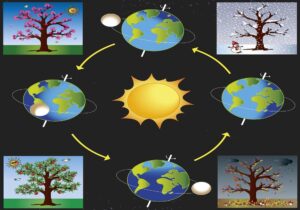Although there is a difference between weather and climate, both are described by a set of the same elements and variables. The basic elements of weather and climate include atmospheric pressure, temperature, precipitation, humidity, wind, clouds, visibility, and sunlight exposure. Let’s explain the elements of weather and climate in detail!

The Basic Elements of Weather and Climate
Despite the difference between weather and climate, both are described by a set of the same atmospheric variables, which are called the elements of weather and climate, namely: atmospheric pressure, temperature, precipitation, humidity, wind clouds, etc.
Atmospheric pressure
Atmospheric pressure, or what is known as air pressure, arises due to the effect of Earth’s gravitational force on the air. It is defined as the force by which the weight of the static air in the atmosphere above the Earth affects the unit area of the Earth’s surface, as this force varies according to the number of molecules that make up the air, their size, and their movement. Which affects its density and temperature, and thus its pressure may rise or fall with the Earth’s rotation.
Atmospheric pressure is an important characteristic of a planet’s atmosphere, as it determines weather patterns, climate, and wind patterns around the world.
Meteorologists use atmospheric pressure values to monitor storms, especially in islands and coastal areas that are constantly exposed to severe storms, as a result of their proximity to large bodies of water, which is one of the main factors in causing changes in atmospheric pressure.
Temperature
Temperature is used to express how hot or cold objects are. The temperature of the atmosphere indicates how hot or cold it is, by determining how high or low it is from zero Celsius, which is the freezing point.
Temperature is usually measured in degrees Celsius (°C), and temperature is an important factor in determining weather and climate because it affects and controls other weather elements, such as precipitation, humidity, clouds, and atmospheric pressure.
Precipitation
Precipitation is defined as the fall of water from clouds to the ground in the form of rain, snow, hail, drizzle, or even fog. Measuring precipitation is useful in determining the appropriate outdoor activities on this day, as well as determining the rise in water levels in streams and rivers.
Precipitation is one of the elements of the climate that can be predicted according to the composition of the region. For example, the desert climate is described as dry, although it is exposed to stormy weather sometimes.
Humidity
Humidity refers to the water vapor content of the atmosphere, and one can sense the level of humidity in the atmosphere.
When the humidity rises, the person’s feeling of malaise increases, due to the decrease in the amount of evaporating sweat, as the process of evaporation of the sweat provides natural cooling for the body.
When the air humidity decreases, the feeling of cold increases due to the evaporation of sweat, and the skin can become dehydrated in a low-humidity climate, due to the evaporation of a greater amount of fluid from the body.
The amount of water vapor in the air is called absolute humidity. The ratio of the amount of water vapor in the air to the amount of water vapor the air can hold is called relative humidity. The amount of water vapor that the air can hold varies with temperature and pressure.
The temperature at which the air saturates the most water vapor possible is called the dew point. At this point, the water vapor in the air begins to condense, as happens when dewdrops form on the leaves of plants in the early morning. Liquid water drops are formed when water vapor in the air cools to the dew point.
Wind
Winds are defined as the movement of air parallel to the Earth’s surface, and winds usually blow from areas of high pressure to areas of low pressure. However, the rotation of the Earth around itself causes the Coriolis Effect, which causes winds to blow at a straight angle with the direction of the atmospheric pressure gradient, especially in the upper atmosphere.
As for the low winds, they rub against the surface of the earth and move in the direction of the pressure gradient to decrease, and these winds are called geostrophic winds, meaning the winds that direct the movement of the earth. In the northern hemisphere, the areas of low pressure are to the left and areas of high pressure are to the right, and vice versa in the southern hemisphere. At an altitude of 9000 meters above the surface of the earth, the speed of the westerly winds exceeds 320 kilometers per hour along narrow areas, and they are called at the time the jet streams.
Clouds
Clouds are one of the most visible features in the sky and are an indication of how the weather may change in the coming hours or days. The term clouds refer to the visible accumulation of water in the atmosphere.
It is worth noting that clouds play a crucial role in the climate system, as they contribute to the cooling of the planet as they are light-colored bodies that reflect sunlight very efficiently into space.
The cloud also controls the duration of sunrise, the brightness of the sky, the amount of sunlight spread, in addition to being the source of precipitation.
Clouds can balance the warming that occurs to the Earth due to greenhouse gases, and may provide protection from the sun’s rays on cloudy summer days, while on cloudy winter nights, they contribute to reducing the heat radiation that the Earth loses at night, thus reducing the drop in temperature. Therefore, cloudless winter nights are usually cooler.
There are several types of clouds that are formed in different ways. Each of them has different effects on the Earth’s climate, some types of clouds help to warm the Earth, while others help to cool it, and these types include:
Stratus clouds are gray, thick and low clouds that prevent sunlight from reaching the Earth and therefore have a cooling effect on the Earth.
Cirrus clouds are high clouds up to 20 kilometers above the Earth’s surface, and allow most of the sunlight to pass through, but may prevent the Earth from losing heat, and therefore have an effect on heating the Earth.
Cumulus clouds appear with sharp edges, and may block sunlight, and may trap the Earth’s temperature depending on its height and thickness.
Sunshine Duration
Sunshine Duration is the amount that the Earth receives from sunlight during a certain period of time in the different weather elements, as it affects either directly the temperature, or indirectly, such as: the effect of the sun on air pressure, humidity.
Horizontal Visibility
Visibility is a secondary component of weather, meaning the degree to which objects can be seen at a certain distance. Horizontal visibility is increasingly important in airports and ports and in cases of fog or freezing and other situations that obscure vision. Visibility can be measured through the forward scattering sensor.
Conclusion: Weather or climate is affected by many factors, and these factors, in turn, affect some of them and the environment in different ways. Among these factors are: atmospheric pressure, wind, sunlight, and clouds, as atmospheric pressure affects the movement of winds, and temperature affects humidity and pressure.
All of these elements are studied to predict the weather and to understand how and when the rain will fall.





